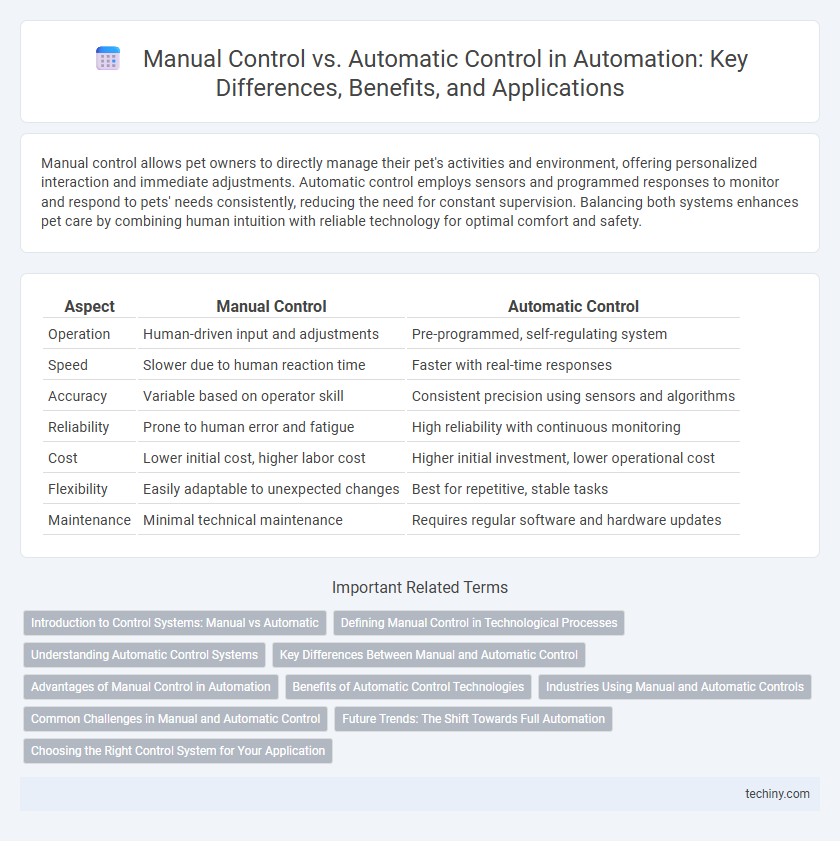Manual control allows pet owners to directly manage their pet's activities and environment, offering personalized interaction and immediate adjustments. Automatic control employs sensors and programmed responses to monitor and respond to pets' needs consistently, reducing the need for constant supervision. Balancing both systems enhances pet care by combining human intuition with reliable technology for optimal comfort and safety.
Table of Comparison
| Aspect | Manual Control | Automatic Control |
|---|---|---|
| Operation | Human-driven input and adjustments | Pre-programmed, self-regulating system |
| Speed | Slower due to human reaction time | Faster with real-time responses |
| Accuracy | Variable based on operator skill | Consistent precision using sensors and algorithms |
| Reliability | Prone to human error and fatigue | High reliability with continuous monitoring |
| Cost | Lower initial cost, higher labor cost | Higher initial investment, lower operational cost |
| Flexibility | Easily adaptable to unexpected changes | Best for repetitive, stable tasks |
| Maintenance | Minimal technical maintenance | Requires regular software and hardware updates |
Introduction to Control Systems: Manual vs Automatic
Control systems differentiate between manual control, where human intervention directly adjusts system variables, and automatic control, which employs sensors and feedback loops for self-regulation. Manual control relies on operator skill and real-time decision-making, making it suitable for simple or variable tasks. Automatic control enhances precision and efficiency by continuously monitoring system outputs and applying corrective actions without human input.
Defining Manual Control in Technological Processes
Manual control in technological processes involves human operators directly managing system functions, typically through interfaces such as buttons, levers, or touchscreens. This control mode requires continuous human intervention to adjust parameters, respond to system feedback, and maintain operation within desired limits. Manual control is essential in scenarios demanding human judgment, flexibility, and immediate decision-making where automated systems may lack contextual understanding.
Understanding Automatic Control Systems
Automatic control systems utilize sensors and feedback loops to continuously monitor and adjust processes without human intervention, ensuring precision and efficiency. These systems rely on control algorithms to maintain desired output levels by compensating for disturbances in real-time. Understanding automatic control involves studying components such as controllers, actuators, and measurement devices working together to achieve stability and optimize system performance.
Key Differences Between Manual and Automatic Control
Manual control requires human intervention for operation, relying on real-time decision-making and physical manipulation of machinery or processes. Automatic control utilizes sensors, actuators, and programmable logic controllers to maintain system stability and performance without continuous human input. Key differences include response time, accuracy, consistency, and the ability to operate in hazardous environments.
Advantages of Manual Control in Automation
Manual control in automation offers precise human judgment and adaptability in complex or unpredictable situations where automated systems may fail. It allows operators to intervene instantly, ensuring safety and customization based on real-time observations. This flexibility is crucial in environments requiring nuanced decision-making beyond programmed algorithms.
Benefits of Automatic Control Technologies
Automatic control technologies enhance system efficiency by continuously monitoring and adjusting processes without human intervention. They improve precision and consistency, reducing errors and operational costs compared to manual control. These technologies also enable faster response times and better scalability in complex industrial environments.
Industries Using Manual and Automatic Controls
Industries such as manufacturing, construction, and mining often rely on manual control systems for tasks requiring human judgment, dexterity, and adaptability. Automatic control systems dominate sectors like chemical processing, automotive production, and energy generation, where precise, continuous, and repeatable operations are critical. The integration of manual and automatic controls enhances operational flexibility, safety, and efficiency across diverse industrial applications.
Common Challenges in Manual and Automatic Control
Manual control often faces challenges related to human error, fatigue, and limited response speed, impacting consistency and accuracy in system operations. Automatic control systems can struggle with sensor malfunctions, software bugs, and difficulties in adapting to unpredicted environmental changes or complex scenarios. Both control methods require rigorous calibration and maintenance to ensure optimal performance and minimize operational risks.
Future Trends: The Shift Towards Full Automation
The future of automation emphasizes a shift towards full automation, reducing reliance on manual control to enhance efficiency and precision in industrial processes. Advances in artificial intelligence, machine learning, and IoT integration enable systems to perform complex tasks autonomously, minimizing human intervention. This trend promises significant improvements in productivity, safety, and scalability across manufacturing, logistics, and smart infrastructure sectors.
Choosing the Right Control System for Your Application
Selecting the appropriate control system depends on factors such as system complexity, precision requirements, and human intervention levels. Manual control offers flexibility and direct human oversight, ideal for simple or variable processes, while automatic control ensures higher efficiency, consistency, and faster response times in complex or repetitive tasks. Balancing cost, reliability, and safety considerations is essential to achieve optimal performance and meet application-specific demands.
Manual Control vs Automatic Control Infographic

 techiny.com
techiny.com